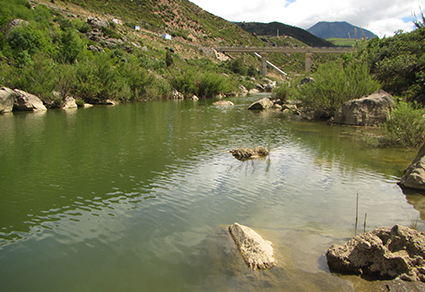References
Álvarez-Presas, M. & Riutort, M. (2014) Planarian (Platyhelminthes, Tricladida) Diversity and Molecular Markers: A New View of an Old Group. Diversity, 6, 323–338. https://doi.org/10.3390/d6020323
Benítez-Álvarez, L., Sluys, R., Leal-Zanchet, A.M., Leria, L. & Riutort, M. (2022) First molecular phylogeny of the freshwater planarian genus Girardia (Platyhelminthes, Tricladida) unveils hidden taxonomic diversity and initiates resolution of its historical biogeography. bioRxiv 2022.07.19.500599. https://doi.org/10.1101/2022.07.19.500599
Ball, I.R. (1974) A contribution to the phylogeny and biogeography of the freshwater triclads (Platyhelminthes, Turbellaria). In: Biology of the Turbellaria. McGraw-Hill, New York, New York, pp. 339–401.
Carbonell, J.A., Céspedes, V. & Green, A.J. (2021) Is the spread of the alien water boatman Trichocorixa verticalis verticalis (Hemiptera, Corixidae) aided by zoochory and drought resistant eggs? Freshwater Biology, 66, 409–420. https://doi.org/10.1111/fwb.13647
Chen, X., Chen, Y., Wu, C. & Wang, A. (2015) A new species of the genus Girardia (Tricladida : Dugesiidae) from China. Zoological Systematic, 40 (2), 166–178. https://doi.org/10.11865/zs.20150202
Gallardo, B., Clavero, M., Sánchez, M.I., Vilà, M., Havel, J.E., Kovalenko, K.E. & Kats, L.B. (2016) Global ecological impacts of invasive species in aquatic ecosystems. Global Change Biology, 22 (1), 151–163. https://doi.org/10.1111/gcb.13004
Gourbault, N. (1969) Expansion de Dugesia tigrina (Girard), Planaire americaine introduite en Europe. Annales de Limnologie, Tome 5 (No. 1), 3–7. https://doi.org/10.1051/limn/1969006
Guareschi, S., Coccia, C., Sánchez-Fernández, D., Carbonell, J.A., Velasco, J., Boyero, L., Green, A.J. & Millán, A. (2013) How Far Could the Alien Boatman Trichocorixa verticalis verticalis Spread? Worldwide Estimation of Its Current and Future Potential Distribution. PLoS ONE, 8 (3), e59757. https://doi.org/10.1371/journal.pone.0059757
Havel, J.E., Kovalenko, K.E., Thomaz, S.M., Amalfitano, S. & Kats, L.B. (2015) Aquatic invasive species: challenges for the future. Hydrobiologia, 750 (1), 147–170. https://doi.org/10.1007/s10750-014-2166-0
Ilić, M.D., Tubić, B.P., Marinković, N.S., Marković, V.M., Popović, N.Z., Zorić, K.S. & Paunović, M.M. (2018) First report on the non-indigenous triclad Girardia tigrina (Girard, 1850) (Tricladida, Dugesiidae) in Serbia, with Notes on its Ecology and Distribution. Acta Zoologica Bulgarica, 70 (1), 39–43.
Kanana, Y. & Riutort, M. (2019) First record of freshwater planarian Girardia tigrina (Platyhelminthes, Tricladida, Continenticola) in Eastern Europe. Zootaxa, 4624 (4), 597–600. https://doi.org/10.11646/zootaxa.4624.4.13
Knakievicz, T. (2014) Planarians as invertebrate bioindicators in freshwater environmental quality: the biomarkers approach. Ecotoxicology and Environmental Contamination, 9 (1), 1–12. https://doi.org/10.5132/eec.2014.01.001
L’Mohdi, O., Bennas, N., Himmi, O., Hajji, K., El Haissoufi, M., Hernando, C., Carbonell, J.A. & Millán, A. (2010) Trichocorixa verticalis verticalis (Fieber, 1851) (Hemiptera, Corixidae): une nouvelle espèce exotique au Maroc. Boletin de la Sociedad Entomológica Aragonesa, 46, 395–400
Meinken, H. (1925) Ein verkannter Laichräuber. Wochenschrift für Aquarien- und Terrarienkunde, 22, 94–96.
Taybi, A.F., Mabrouki, Y., Chavanon, G., Berrahou, A. & Millán, A. (2020) The alien boatman Trichocorixa verticalis verticalis (Hemiptera: Corixidae) is expanding in Morocco. Limnetica, 39 (1), 49–59. https://doi.org/10.23818/limn.39.04
Ronquist, F., Teslenko, M., Van Der Mark, P., Ayres, D.L., Darling, A., Höhna, S., Larget, B.,
Liu, L., Suchard, M.A. & Huelsenbeck, J.P. (2012) Mrbayes 3.2: Efficient bayesian phylogenetic inference and model choice across a large model space. Systematic Biology, 61 (3), 539–542. https://doi.org/10.1093/sysbio/sys029
Saló, E., Baguñà, J. & Romero, R. (1980) Les Planàries d’aigües dolces a Catalunya i les illes Balears. I. Clau sistemàtica i distribució geogràfica. Butlletí de la Institució Catalana d’Història Natural, 45, 15–30.
Sluys, R., Kawakatsu, M. & Ponce De León, R. (2005) Morphological stasis in an old and widespread group of species: Contribution to the taxonomy and biogeography of the genus Girardia (Platyhelminthes, Tricladida, Paludicola). Studies on Neotropical Fauna and Environment, 40 (2), 155–180. https://doi.org/10.1080/01650520500070220
Sluys, R., Kawakatsu, M. & Yamamoto, K. (2010) Exotic freshwater planarians currently known from Japan. Belgian Journal of Zoology, 140, 103–109.
Wu, J.P. & Li, M.H. (2018) The use of freshwater planarians in environmental toxicology studies: Advantages and potential. Ecotoxicology and Environmental Safety, 161 (May), 45–56. https://doi.org/10.1016/j.ecoenv.2018.05.057


